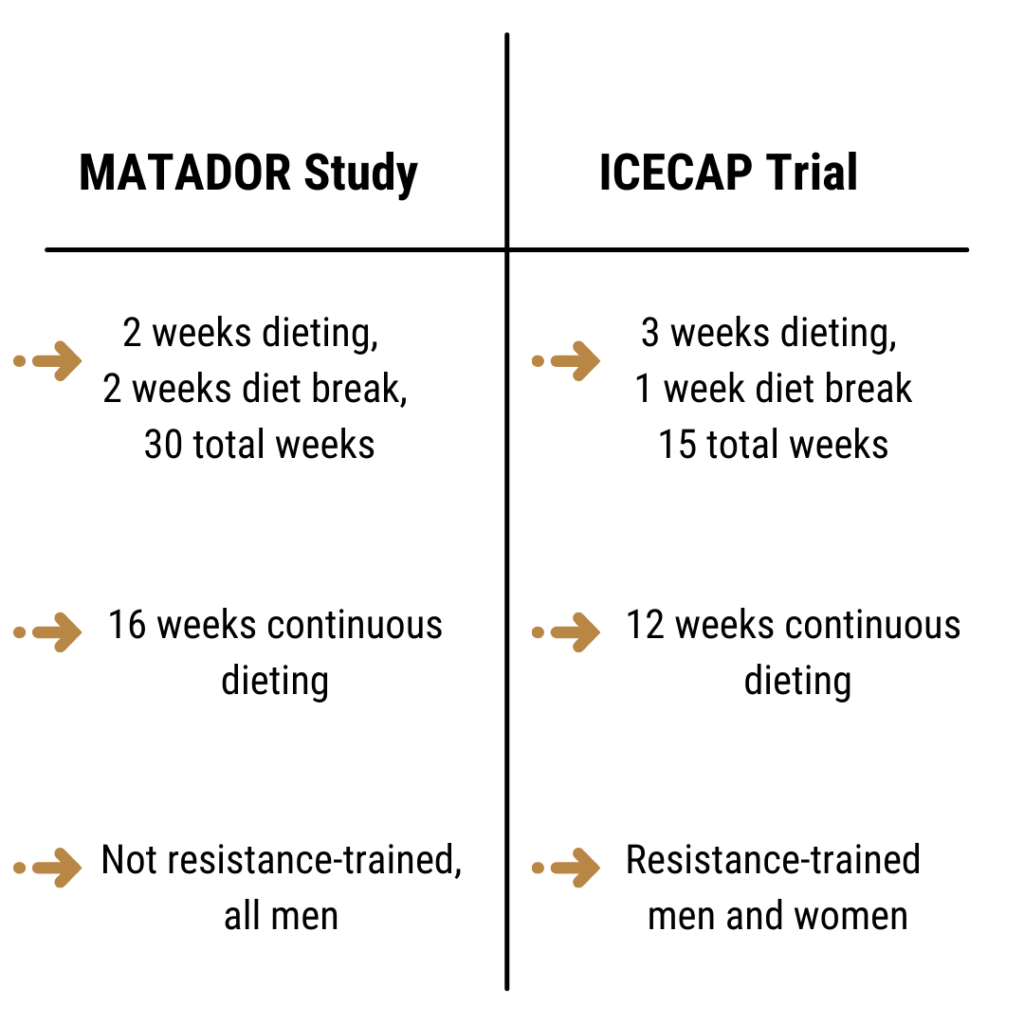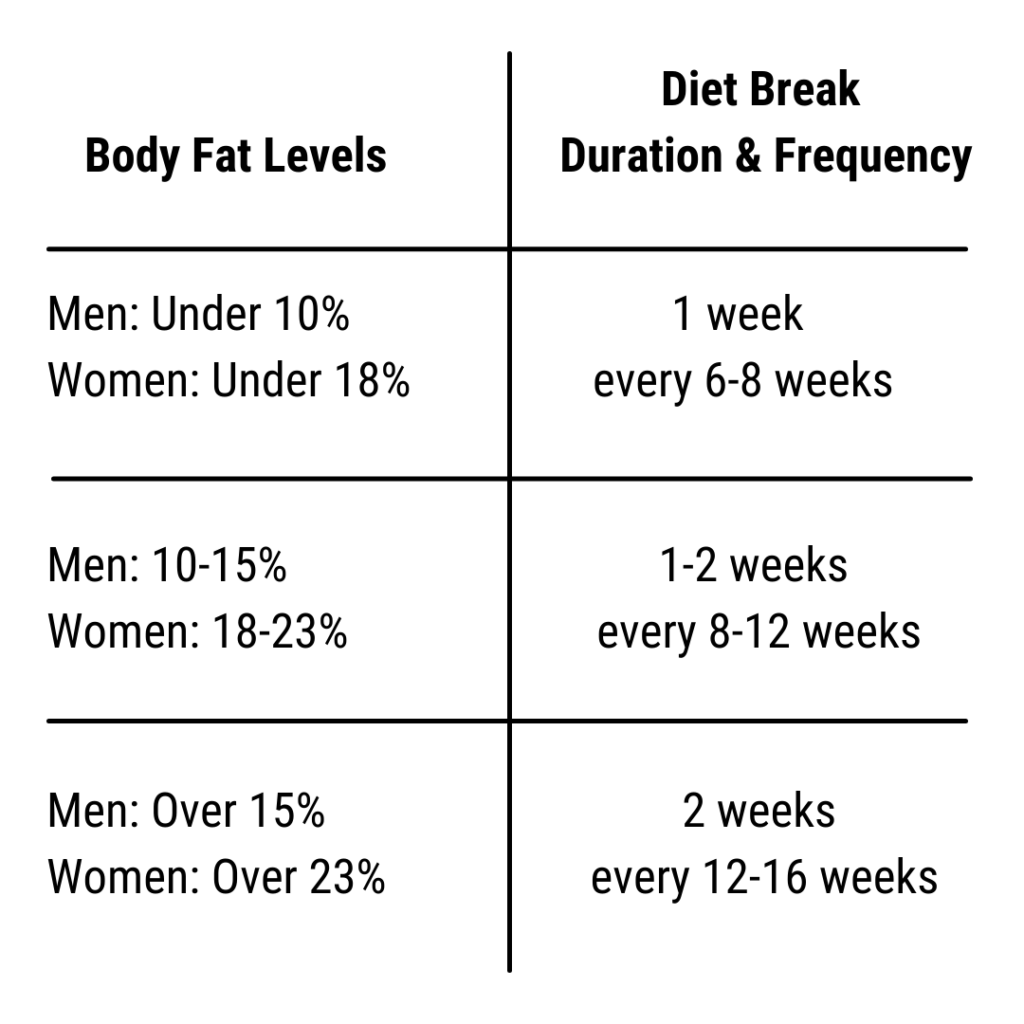Diet Breaks For Fat Loss: Everything You Need to Know

Table of Contents
- What Is a Diet Break?
- Why Take a Diet Break?
- How To, How Frequent, and How Long?
- When to Schedule a Diet Break
- After the Diet Break
- Diet Break vs. Refeed—What’s the Difference?
What Is a Diet Break?
A diet break is a planned period of eating at maintenance calories which usually lasts 1-2 weeks. This increase in calories from a deficit to maintenance primarily comes from an increase carbohydrates. You can add more fats into your diet during this time as well, but an increase from mainly carbohydrates is preferable. I’ll explain why in the next section.
The duration of diet break depends on the individuals body fat levels, how long they’ve been dieting, how large their calorie deficit is, and many other biofeedback markers like sleep, hunger, mood, energy levels, performance in the gym, and more.
During this time, you’ll most likely gain weight. It’s very unlikely to be body fat since you’re eating at maintenance and you’d need to be eating more calories than that to put on body fat in 1-2 weeks. But if you increase carbohydrate consumption, you could be holding more water weight.
This increase in weight is usually due to an increase in glycogen since you’re consuming more carbohydrates. There’s also an increase in water weight that comes with an increase in carbohydrate intake. And lastly, you’re eating more food which means you just have more food in your gastrointestinal tract which adds weight. So, don’t worry about any temporary increases in body weight. Once the diet break is over and you return to a deficit, you’ll most likely lose the weight and even more, and end up at a lower body weight than you were prior to the diet break. I can’t guarantee that outcome, but I see it often with the clients I work with.
Why Take a Diet Break?
One of the main purposes of a diet break is to provide both psychological and physiological relief from being in a calorie deficit. To give your mind and body a break from the tedious dieting, and reverse some of the effects of metabolic adaptation.
The relief that comes with a diet break often improves dietary adherence and motivation once the break is over and you return to a calorie deficit.
When you have a lot of fat to lose, it can be very difficult to stay motivated and sustain a deficit for months and months. Likewise, when you’re trying to get very lean, it becomes more and more challenging to continue to lose body fat the leaner you get. Diet breaks can be beneficial in both cases.
Just like Major League Baseball players have the All-Star break where they get a break from their regular season games. Players in the NFL only play one game a week and have a bit of rest between games. You have days off from the gym and deload weeks where you give your body and mind a break from intense training. Many of us have weekends where we get a break from work. You also need a break from dieting at times. These planned breaks allow for better outcomes in the long-run.
A diet break is also a great time to practice eating and living at maintenance. It’s important to build the habits and make the mindset shift and lifestyle changes that will allow you to maintain your weight after you’ve lost it. You’re not going to diet forever. So once you eventually achieve the body composition or body weight you want, you now have to maintain that or continue to improve, and avoid gaining the weight back.
The increase in calories primarily from carbohydrates can help fuel some great workouts, improve recovery, and reduce the risk of losing muscle. Simply increasing calories to maintenance and not being in a deficit greatly reduces the risk of muscle loss. People generally just feel better and have more energy with more carbohydrates. Also, carbs increase insulin which results in a decrease in cortisol, the main stress hormone. A calorie deficit, hard training in the gym, and any other life stressors can build up and result in a sustained elevation in cortisol levels. Having cortisol levels too high too often can impact your mood, recovery, sleep, and increase water retention. The combination of eating at maintenance and more carbs can help alleviate the fatigue and stress that comes with dieting.
The MATADOR Study
There have been researchers that have studied diet breaks and how effective they are when dieting. The MATADOR (Minimizing Adaptive Thermogenesis And Deactivating Obesity Rebound) study is a popular one that found diet breaks to be very beneficial.
This study consisted of two groups of obese men:
- One group dieted for 16 consecutive weeks, no diet breaks.
- The other group dieted for 2 weeks, followed by a 2 week diet break eating at maintenance calories.
Researchers looked at the differences in fat mass lost, lean body mass retention, and changes in metabolic rate between the two groups.
The group doing the 2 weeks of dieting followed by 2 weeks diet break lost more body fat, kept more lean body mass, and saw a smaller reduction in metabolic rate, meaning less severe metabolic adaptation was experienced.
The one downside for the diet break group in this study was that it took them twice as long to lose weight compared to the continuous dieting group. It took the diet break group a total of 30 weeks, and the continuous dieting group 16 weeks.
The ICECAP Trial
This study consisted of two groups of resistance-trained men and women.
- One group dieted for 12 consecutive weeks, no diet breaks.
- The other dieted for 3 weeks, followed by a 1 week diet break eating at maintenance calories for a total of 15 weeks.
Unlike the MATADOR study, the diet break group did not see any notable difference in fat mass lost, lean body mass retention, or differences in metabolic rate. The diet break group did take longer to lose body fat just like those in the MATADOR study.
The diet break group did see higher levels of the hormone peptide YY. This hormone helps you feel full after eating and reduces appetite. It also slows down the speed of food moving through the digestive tract. Peptide YY decreases when food is low, like when dieting. So, an increase in this hormone can help improve satiety, which makes adhering to the diet easier.
Comparing Studies
The diet break group in the MATADOR experienced more fat loss, more lean body mass retention, and a higher metabolic rate at the end of the diet compared to the continuous dieting group.
The diet break group in the ICECAP Trial experienced no differences in fat loss, lean body mass retention, and metabolic rate in comparison to the continuous dieting group.
However, both studies did find a reduction in hunger and improved satiety among the diet break groups. A reduction in hunger and improved satiety is highly likely to improve dietary adherence, making the diet feel less challenging and tedious.
Even though more fat loss, better lean body mass retention, and less metabolic adaptation aren’t guaranteed and are only potential benefits, the fact that hunger is reduced is a good enough reason to incorporate diet breaks for most people. The easier it is to stick with your diet, the less diet fatigue you’ll experience, and reaching your body composition goals won’t seem as challenging.
Incorporating diet breaks does extend the time it takes to achieve your goals, but when you look at the benefits and potential benefits, the extra time spent makes it worthwhile in my opinion. As I mentioned earlier, the diet breaks are a great time to practice eating and living at maintenance calories. Since you won’t be dieting forever and will eventually spend the majority of your time at maintenance, it’s good to get a feel for what it’s like.
These two studies varied in a few ways. Maybe similar results would have been found if the diet to diet break ratios were the same, if both studies were done for the same duration, and if all participants were resistance-trained. There are other smaller details that could influence the results, but these are the main differences that are more easily controlled.

How To, How Frequent, and How Long
How To
Leptin is one of the main hunger hormones that suppresses hunger by telling your brain that you have enough energy. This hormone decreases the leaner you get. It also increases energy expenditure through brown adipose tissue (BAT) thermogenesis. When leptin levels drop, you’ll experience an increase in hunger and appetite, and a drop in energy expenditure.
Carbohydrates have a greater effect on leptin than protein and fats do. Remember earlier when I mentioned the increase in calories during a diet break should primarily come from carbohydrates? This is why.
More carbohydrates will result in higher levels of leptin which will help suppress hunger and could potentially increase energy expenditure. These changes are very short-lived, but they can be beneficial over course of a 1-2 week diet break. As we mentioned earlier, less hunger typically results in better dietary adherence and less diet fatigue. And as we mentioned earlier, carbohydrates can help with recovery, training performance, retaining muscle mass, and lowering cortisol levels.
Here’s an example of how you could adjust your calorie intake for a diet break:
If you want to increase calories by 500 to get to maintenance calories, you can add 400 calories from carbohydrates, and the remaining 100 calories from fat.
Carbohydrates have 4 calories per gram:
- 400 calories from carbohydrates divided by 4 calories per gram = 100 grams of carbohydrates
Fat has 9 calories per gram:
- 100 calories from fat divided by 9 calories per gram = 11.11 grams of fat
- Round 11.11 grams of fat down to 10 grams of fat.
So when increasing calories to maintenance, you could add 100 grams of carbs, 10 grams of fat, and keep protein the same. This is just an example, and you don’t have to add those exact amounts of carbs and fats, but do make sure the majority of the additional calories are coming from carbs.
Don’t make the mistake of treating a diet break like a free week to eat whatever you want in any amount. That’s not the point. You should stick with your good eating habits and behaviors. Your food is still being weighed and tracked. You’re still in control and doing the same things you would while dieting, except more calories are being consumed and you have a bit more flexibility.
How Frequent and How Long
There are many different ways to go about diet breaks:
- 2 weeks on, 1 week break
- 2 weeks on, 2 weeks break
- 3 weeks on, 1 week break
- 3 weeks on, 2 weeks break
- 4 weeks on, 1 week break
- 4 weeks on, 2 weeks break
You get the idea.
This can go up to 8-12 weeks or even more. Sometimes a 1-week diet break is enough, and other times 2 weeks is more beneficial. It’s highly individual and depends on the persons body fat levels, training intensity and frequency, size of the calorie deficit, stress levels, sleep, hunger, cravings, energy levels, recovery, emotional and psychological state, and how quickly the persons experiences diet fatigue. These are all things I track with my clients, and they’re referred to as biofeedback markers. Having this information allows me to make better decisions on what our next move is, and what is working well and what’s not.
The leaner you are, the more frequently you should incorporate diet breaks. The more fat you have to lose, the less frequent your diet breaks should be. This is because the leaner you are, the more likely you are to lose muscle mass, and the more challenging it becomes to stick with your diet. When you have more body fat to lose, your body has a large supply of body fat to pull from for energy, so your body is much less likely to break down muscle tissue for energy.
This chart below is a general rule of thumb to follow, but again, diet break duration and frequency will vary person to person depending on the factors we mentioned earlier.

When to Schedule a Diet Break
I’d suggest scheduling diet breaks at times when more flexibility with your diet would be useful. Such as birthdays, vacations, weddings, and holidays.
If you don’t have any life events that involve more food, you can also schedule them during a hard week of training, like towards the end of a mesocycle before a deload.
Another option is to schedule them during a deload week. A deload week is a time to let the body recover, and the extra calories can help with that. You get both a training and diet break at the same time. I take this approach with a lot of my clients, but not always. Some people don’t like the fact that they’re eating more and working out less. They feel off and uneasy. For others, they love it and come back feeling amazing.
After the Diet Break
Ideally, a diet break would reverse some of the metabolic adaptations that come with dieting. In this case, this means you could return to your pre-diet break calories and continue to lose weight. Sometimes this happens, sometimes it doesn’t. But the goal is to lose body fat while consuming as many calories as possible. So always return to your pre-diet break calories first, give it 2 weeks, and make any adjustments if needed to continue dropping body fat.
Diet Break vs. Refeed—What’s the Difference?
A refeed is a short period of 1-3 days of eating at maintenance calories or above, usually maintenance.
A refeed is basically a mini-diet break. Instead of eating at maintenance for 1-2 weeks, it only lasts 1-3 days.
Another difference is that calories are sometimes pushed above maintenance and into a small surplus. You see a surplus more often with refeeds because of their shorter duration, only 1-3 days. If the goal is fat loss, you wouldn’t want to go 1-2 weeks in a surplus. You’re already extending the time it’ll take to reach your goals by increasing calories to maintenance during a diet break. Increasing calories to a surplus would likely further extend that time even more.
The purpose of a refeed is the same as a diet break, and they’re both done very similarly. You increase calories primarily from carbohydrates to increase leptin, boost performance in the gym, retain lean body mass, potentially lessen the effects of metabolic adaptation, and provide a psychological relief from dieting.
Diet breaks are a great tool for long-term success in regards to fat loss and keeping the body you want. Use them wisely, and remember, it’s not an excuse to go eat whatever you want in any amounts.
Need some guidance with your fat loss and body composition goals? Fill out the form below and I’ll get back to you as soon as I can!
